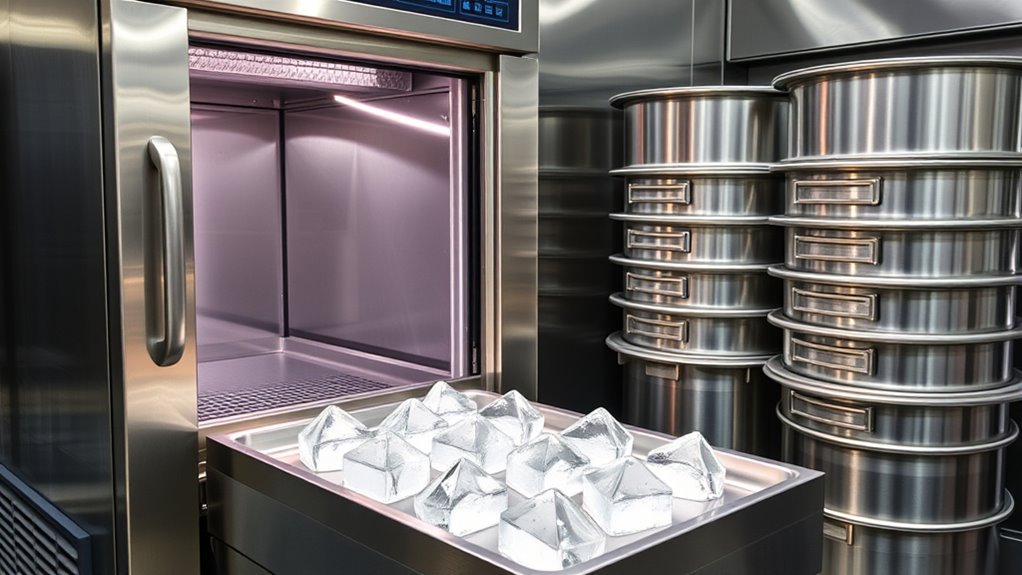To cool large batches effectively, you can choose between ice wands and blast chillers. Ice wands are portable and ideal for targeted, quick cooling of smaller areas or individual items. Blast chillers use powerful refrigeration and forced air to quickly and evenly lower temperatures across extensive batches, locking in freshness and safety. Both methods have their strengths depending on your needs. Keep exploring to discover which solution best suits your specific cooling requirements.
Key Takeaways
- Ice wands are ideal for quick, targeted cooling of small quantities within large batches.
- Blast chillers provide uniform, rapid cooling for entire large batches through forced air circulation.
- Ice wands are portable and low-cost, suitable for immediate, localized temperature reduction.
- Blast chillers are designed for continuous, large-scale processing, maintaining product safety and quality.
- Choosing between them depends on batch size, product sensitivity, and cooling speed requirements.

Cooling large batches efficiently is essential to maintaining product quality and safety in many industrial processes. When handling substantial volumes of perishable or temperature-sensitive materials, you need reliable methods to bring temperatures down quickly without compromising the product’s integrity. Two popular solutions are ice wands and blast chillers, each designed to meet different cooling demands. Ice wands are simple, portable tools that utilize frozen water or other cooling agents to rapidly reduce temperature, but they’re generally best suited for smaller or more targeted applications. For larger batches, blast chillers are often the go-to equipment, capable of rapidly lowering temperatures across extensive quantities.
One of the most effective techniques for rapid freezing is the use of liquid nitrogen. With its extremely low temperature of -196°C, liquid nitrogen enables you to achieve rapid freezing that preserves the texture, flavor, and nutritional content of your products. When you introduce liquid nitrogen into the cooling process, it creates an ultra-fast phase change, turning from liquid to gas and removing heat at an incredible rate. This rapid freezing prevents the formation of large ice crystals, which can damage cell structures and degrade quality. Instead, it results in a finer, more uniform ice formation that maintains the product’s original quality.
Liquid nitrogen achieves rapid freezing at -196°C, preserving product quality and preventing ice crystal damage.
In industrial settings, integrating liquid nitrogen for rapid freezing can be straightforward. You might use spray techniques or immersion methods, where products are immersed in or sprayed with liquid nitrogen to freeze them almost instantly. This approach is especially valuable when dealing with delicate or high-value items that require quick temperature reduction to prevent spoilage or degradation. Rapid freezing also minimizes the time products spend in the temperature danger zone, reducing the risk of microbial growth and prolonging shelf life. Understanding the Kia Tuning can inspire innovative cooling solutions tailored to specific industrial needs.
Blast chillers also excel at large-scale cooling, especially when speed and consistency matter. They use powerful refrigeration systems combined with forced air circulation to uniformly reduce temperatures across large batches. When you load products into a blast chiller, you can expect rapid, even cooling that helps lock in freshness and prevent microbial growth. Unlike ice wands, blast chillers are designed for continuous operation and are ideal for processing multiple batches efficiently. They are especially useful in food production, pharmaceuticals, and other industries where maintaining strict temperature controls is vital.
Both liquid nitrogen rapid freezing and blast chillers are invaluable for cooling large batches, but the choice depends on your specific needs. Liquid nitrogen offers unmatched speed and precision, perfect for high-value or delicate items, while blast chillers provide reliable, consistent cooling for bulk processing. Understanding the strengths of each method allows you to optimize your cooling processes, ensuring product quality, safety, and efficiency at every stage.
Frequently Asked Questions
What Are the Energy Consumption Differences Between Ice Wands and Blast Chillers?
Ice wands generally use less energy, making them more energy-efficient for small to medium batches, leading to lower operational costs. Blast chillers, while faster and more efficient for large batches, consume more power due to their high cooling capacity. If you’re focused on reducing operational costs and energy use, ice wands are a better choice for smaller volumes, whereas blast chillers excel in large-scale cooling but at higher energy consumption.
How Do Maintenance Requirements Vary for Ice Wands Versus Blast Chillers?
You’ll find that blast chillers typically require more intensive maintenance, with regular cleaning protocols needed to prevent buildup of food residues and guarantee ideal performance. They also demand proper storage, often in designated areas to avoid damage. Ice wands, on the other hand, have simpler maintenance, mainly requiring frequent cleaning to prevent mold and bacteria. Their storage needs are minimal, making them more convenient for everyday use.
Are There Specific Food Safety Standards for Large Batch Cooling Methods?
Yes, there are specific food safety standards for large batch cooling methods. You must follow food safety regulations that ensure rapid cooling to prevent bacterial growth. The cooling process standards require you to chill food from 135°F to 41°F within four hours. Proper documentation and regular equipment maintenance are essential to stay compliant. Always monitor temperatures closely and adhere to these guidelines to keep food safe during large batch cooling.
Can These Cooling Methods Be Integrated Into Existing Kitchen Workflows?
Did you know that 85% of kitchens successfully integrate advanced cooling methods? You can seamlessly incorporate ice wands and blast chillers into your workflow by planning carefully and adjusting your procedures. Staff training is essential; it guarantees everyone understands how to use these tools efficiently and safely. With proper planning and training, you’ll streamline your large batch cooling process, improve food safety, and boost overall kitchen productivity.
What Is the Typical Lifespan of Ice Wands Compared to Blast Chillers?
Ice wand durability generally lasts around 1 to 3 years with proper maintenance, while blast chiller longevity can extend up to 10-15 years. You’ll find that ice wands may need replacement sooner due to wear and tear, especially with frequent use. In contrast, blast chillers are built for durability, offering a longer lifespan if you keep up regular servicing. Proper care maximizes both your investment’s lifespan.
Conclusion
As you master cooling large batches, think of your ice wands and blast chillers as the gentle guardians of freshness, silently preserving the essence of your creations. They symbolize your commitment to quality and precision, turning fleeting moments into lasting memories. With each chilled batch, you craft not just food, but a cool sanctuary where flavors stay vibrant and vibrant. Embrace these tools as your trusted allies, ensuring every dish remains a shining example of your skill and care.









